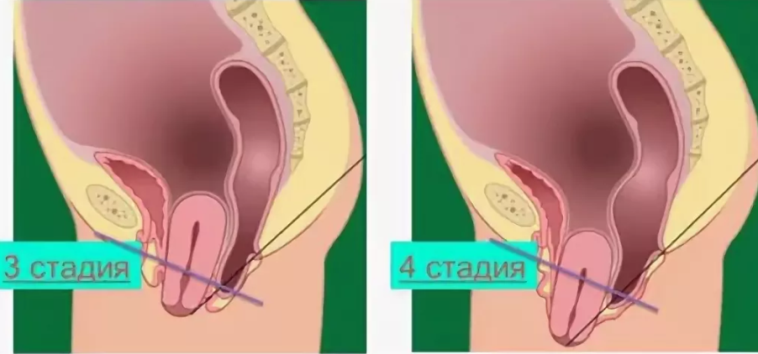If you were diagnosed with uterine omission, then read the article. It has a lot of useful information.
Content
- Owl of the rear, front wall of the uterus, cervix: symptoms
- Uterine prolapse: causes
- Degree of uterine prolapse: list, photo
- Uterine omission in women - prevention, strengthening at home: Kegel gymnastics, what exercises to do?
- How to treat uterine prolapse - what to do: operation
- How to treat uterine prolapse without surgery: pessary
- Owl of the uterus in old age - what to do: types of uterine rings, how to use it correctly?
- Uterus prolapse after childbirth: how effective is the bandage?
- When prolapping the uterus, is it possible to get pregnant?
- Uterine prolapse: consequences
- Can the uterine prolapse be affected by urination, rectum?
- After the uterine omission surgery, after treatment with gymnastics: reviews
- Uterine omission: video
- Video: Symptoms of uterine prolapse. About the most important thing. Health program for Russia 1
If the uterus drops a little during life, this is normal. She has a birth, especially heavy, without cesarean section. It harms the uterus and frequent lifting and wearing weights - this is the most typical reason for the settlement of the organ, because in this case the pressure on the pelvic bottom increases. It is especially harmful to lift weights in a bent position. In addition, obesity, as well as a frequent strong cough, plays an important role.
Gynecologists consider the cause of the weakness of connective tissue a dubious. The pelvic bottom is a vulnerable place in the body of every woman. Strengthening the muscles of the bottom of the pelvis using suitable exercises is, of course, a good idea. But, if the disease is already progressing, then it needs to be treated. In this article, read more about the causes of such a pathology, symptoms, consequences and methods of treatment.
Owl of the rear, front wall of the uterus, cervix: symptoms

Signs of pathology are manifested already in the last stages of the disease. At first, the omission of the posterior, front wall of the uterus, the cervix flows almost asymptomatic. The woman does not hurt anything, there is no discomfort. In the later stages, may appear uterus loss And this will already be accompanied by unbearable pain.
When the rear wall of the vagina is lowered, when the process goes into an irreversible stage, such symptoms appear:
- Sharp pain in the lower abdomen and lower back
- Pain in the vagina itself
- Long and abundant menstruation
- Unpleasant sensations and discomfort during intercourse.
It is worth knowing: During the development of pathology, the rear wall of the uterus can affect the rectum, causing its deformation, as well as constipation, hemorrhoids and subsequently fecal incontinence.
In addition, a woman is dulled in sexual desire, leading to the pelvic dissolution. Almost always, the uterine prolapse provokes the development of varicose veins, which leads to swelling of not only the genitals, but also the lower extremities. The woman feels constant heaviness in her legs and even pain after prolonged walking.
When the front wall of the vagina is lowered, such symptoms are observed:
- Reducing the sensitivity of the vagina.
- The narrowing of the vaginal move.
- Painful sensations in the perineum and lower back. It is usually intensified after loads.
- The feeling that an extraneous object is present in the vagina.
- Violation of urination - delay or, conversely, involuntary release of urine.
The displacement of the anterior wall of the vagina can provoke the appearance of infections in the genitals. In the later stages, discharge in the form of white, and later with blood clots, is observed.
When the walls of the cervix are lowered There are such symptoms:
- Painful sexual intercourse
- Severity with excessive pressure in the lower abdomen
- External genitalias are swelling
- Urine or feces
- Aching pain in the lumbar region, giving to the inguinal region
- Disorder of menstruation
- The mucous membrane of the vagina is covered with erosion and sores
In the first stages of any of these pathologies, a woman does not turn to a gynecologist, since she is not bothering her. But at the prosecutor’s examination, the doctor will definitely notice a small prolapse and prescribe treatment.
Uterine prolapse: causes

The disease is due to the fact that muscle tissue on the abdominal wall is weakened, on the pelvic bottom, which helps to keep the organs in normal condition. Due to the fact that intra-pressure pressure rises, the organs shift to the bottom. Also, the causes of uterine omission can be:
- Multiple births
- Crotch injuries
- Multiple pregnancy
- The birth of a big child
- Uterine fibroids
It is important to constantly keep your body in good shape. If you do not play sports, then accordingly, there will be weakening of the muscles and sagging of the organ.
Degree of uterine prolapse: list, photo
Doctors identify 4 degrees Owl of the uterus. Here is a list and photo:

- Initial or first degree. There are almost no symptoms. At the examination, the gynecologist indicates a small prolapse of the walls of the vagina. The uterus can be slightly reduced downward.

- The second degree. The uterus is located inside the vagina. If the doctor asks the patient to strangle and perform a functional test (bend his knees to himself or lie on a chair just below), then the cervix is \u200b\u200bobserved outside. With this extent, pain and discomfort appear.

- The third degree. At this stage, the uterus and at rest protrudes from the sexual slit.
- The fourth degree. All internal genital organs fall out. The woman feels discomfort while walking, feels severe pain in the lower abdomen.
At the beginning of the disease, you can easily adjust the condition of the exercises. In the last stages, you will have to wear a fallopian ring, a bandage or, if a doctor prescribes, you will need surgery. Read more about treatment below in the text.
Uterine omission in women - prevention, strengthening at home: Kegel gymnastics, what exercises to do?

It is worth knowing: With the uterine prolapse in women, prevention should be carried out so that the disease does not progress, and the strengthening of muscles with the help of Kegel gymnastics. All this is done at home - simple and easy.
How to treat uterine prolapse - what to do: operation

Until the signs are manifested or accompanied by discomfort and are not worried, treatment is not required. However, if they cause suffering, or the uterus has changed its situation too much, the help of a specialist needs. How to treat uterine prolapse, what to do?
First, the gynecologist prescribes Kegel's exercises. If classes do not help, then more global measures are being taken. In later stages, an operation may be needed. Previously, women with this diagnosis were operated on. It is worth knowing:
- Surgery is not the only option.
- Even 10-20 years ago, gynecologists quite often performed operations to remove the organ, although this was not always necessary.
- Today, such an intervention can be considered only when a woman suffers greatly from prolapse or, for example, the loss of the uterus has already occurred.
- But even in this case, all possible risks that the operation may entail are weighed.
Be sure to do not postpone the consultation if you are concerned about the discomfort in the vaginal, the bottom of the abdomen. If you do not take measures now, then there will be irreversible consequences that entail only the complete removal of the body.
It is worth knowing: The operation also does not solve all problems. Especially if you have excess weight and you do not play sports. The walls of the vagina, the cervix, along with the bladder, may appear. As a result, urination problems, infections and other unpleasant problems.
In many patients, even after removing the uterus, sagging walls of the cervix may occur if it was left and the walls of the vagina. In this case, an operation to install a special surgical grid is also prescribed, which supports organs and does not allow the muscles to sag.
How to treat uterine prolapse without surgery: pessary

An alternative to surgery is a gynecological pessary or a fallopian ring. Helps treat uterine prolapse without surgery. This device from silicone or plastic looks - depending on the use - as a ring and holds the vagina or the uterus in a natural position, preventing its further prolapse.
Remember: The pessary should change every six to eight weeks.
It is used inside the vagina in order to support organs. This device is also installed to prevent the progression of the disease, to eliminate uncomfortable sensations, normalization of the patient's well -being. Pessary is the most effective way to prevent serious complications and inflammatory diseases. The uterine ring can be used in such conditions and diseases:
- When the organs and uterus falls outside the vagina
- Disease that occurs in old age
- Before the operation
- Due to the inefficiency of conservative treatment
- Due to contraindications to operations
- While maintaining multiple pregnancy
- Treatment of urinary incontinence
The uterine ring helps to cope with the pathology even if the disease is at the most neglected stage, with it you can make life easier for patients, remove pain. During pregnancy, the uterine ring can be used to save. In some cases, it is used for such pathologies:
- Violation of ovarian indicators
- With softening the uterus
- Not timely discovery
- Due to anamnestic data in which spontaneous miscarriages, premature birth and abortion are present
Also, the ring can be used due to the fact that with a previous pregnancy, a cesarean section was carried out, or with severe physical exertion. About how to install a pessary and which one to choose for yourself, read below in the text.
Owl of the uterus in old age - what to do: types of uterine rings, how to use it correctly?

In old age, the disease is usually progressing. But even in this case, an operation is not always prescribed. What to do in this case? Women with uterine at 50 And older, as well as women during pregnancy or at a young age, a gynecologist can prescribe the wearing of the uterine ring.
It is worth knowing: For the manufacture of pessaries, silicone or latex materials are used, such material has hypoallergenic properties, it is of high -quality and does not cause irritation on the surface of the genital organs. There are many types of rings on the pharmacy market, each species is used in a certain case and in pathology.
There are several types of pessaries:
- Ring. Such a device has a round shape from the outside. Using such a device, you can fix the uterus and urethra.
- Mushroom -shaped. This type of ring resembles a mushroom with a leg, this type of device is used in such cases when other species do not have a therapeutic effect. This device can be worn no more than 1 day.
- Cubic rings Used in the most severe and neglected cases to derive physiological discharge. It is a cube with concave into the walls. They cannot be worn longer than the due date.
- Cup pessaries. They have a spherical shape and hole in the center, these devices are used in the initial stages of pathology.
There are also other types of pessaries. A certain type of uterine ring is selected by a doctor on the basis of a specific clinical case and individual characteristics of the patient.
The dimensions of the uterine rings:
- It is impossible to independently determine which size is necessary, therefore, only the attending physician is engaged in the procedure for the selection of a suitable size after diagnostic procedures.
- In the early stages of the disease or with slight prolapse, it is recommended to use ordinary round rings to support.
- The same rings are selected for pregnant women.
- If prolapse reaches the fourth stage, then they choose a cup -like type of pessary.

How to install a gynecological ring:
- To do this, you need to study the instructions for use, because when falling in the uterus, it is important to be able to insert the ring yourself.
- The first introduction is carried out under the supervision of medical workers, after the device is used at home.
- Some devices are installed once and are not extracted.
The procedure is carried out in several stages:
- Messify and treat the uterine ring with a solution.
- Then process the pessary with grease or cream so that the installation is comfortable and light, and so that mucous skin is not injured.
- The next step will be the introduction of a pessary into the vagina. Squeeze it in the palm of your hand, after which straighten the device and attach to the cervix
- The device should not be too much pressure on the cervix.
If you can’t insert a pessary on your own, then ask for the first time to help the gynecologist. Then you get the fuck and will do it yourself.
Uterus prolapse after childbirth: how effective is the bandage?

Bandage - This is a medical support device. It is made of special durable fabrics that are pleasant to sensations. This device encircles the hip area along with the crotch. The bandage is fixed using Velcro and plastic elements. How effective is the bandage when the uterus is omitted after childbirth? Here's the answer:
- If you wear a bandage, then the uterus will no longer exert such a large pressure on neighboring organs as without it.
- The woman’s genitals will be in the correct anatomical position. Thanks to this, pains are reduced, problems with involuntary urination and gas release disappear.
- Effectively wear a bandage at the initial stages of uterine prolapse - with prolapse of the 1st and 2nd degree.
Also, along with the wearing of the bandage, you can perform Kegel exercises. Such a device does not interfere with this.
Remember: Only a doctor should appoint a bandage. Often experts are prescribed to wear this device with pessary, and not only after childbirth.
When prolapping the uterus, is it possible to get pregnant?

At 1 degree Uterine omission in a woman does not have pain, the childbearing function is preserved. Therefore, pregnancy can occur, like a healthy woman.
Pregnancy at 2 degrees Also cannot be excluded. During this stage of pathology, a woman is disturbed by pain. But she may not guess the presence of a disease. She will learn about this already at the reception of the gynecologist when she comes to register.
Woman s 3 or 4 stages Owl of the uterus is not devoid of ovulation, and the conducting function of the cervical canal works normally. Therefore, in this case, pregnancy can also occur. Although this is unlikely, but theoretically possible.
Uterine prolapse: consequences

This is not bad and not scary, but some women are afraid of the consequences, they are ashamed of this and do not want to see a doctor. Owl is accompanied by rather unpleasant symptoms:
- With a cough, sneezing or laughter, a little urine is involuntarily distinguished.
- Or vice versa, the woman goes to the toilet, but cannot completely free the bladder.
- Sometimes there are problems with bowel movements, an unpleasant sensation of foreign bodies in the lower abdomen or when walking and sitting.
- But it also happens that the prolapse is not accompanied by any symptoms.
Complaints are very diverse and depend on how much the uterus has fallen. These are not all the consequences. Here are a few more:
- When the uterus changes position, it can squeeze the vagina, bladder or rectum.
- The described symptoms are manifested depending on what pressure the uterus exerts.
- In addition, other organs can be slightly shifted: the vagina sometimes protrudes and can be felt between the labia.
- The bladder can slide towards the vaginal, then the so -called "cystocele" or the loss of the bladder occurs.
- If the rectum is affected, rectocele may develop.
- If the uterus settles more, the cervix can be felt outside. In rare cases, the organ falls out by itself.
If the uterine omission occurs during pregnancy, then this can be threatened with complications. The fact is, along with the omission of the uterus, the prolapse of the cervix or vagina can develop. The release of internal organs can provoke the development of infection, which can be transferred to the inner cavity of the uterus. Because of this, intrauterine infection occurs, which can lead to a delay in the development of the fetus. There may also be premature birth and various congenital defects.
At the initial stages of the development of pathology, symptoms of uterine omission may increase, especially in the first trimester. This is due to the increase in the size and weight of the body of the childbearing organ due to the growing embryo.
Can the uterine prolapse be affected by urination, rectum?
As mentioned above, uterine prolapse can affect urination and rectum. If the uterus presses on the bladder, it can stick out into the vagina. This condition is called cystocele. If the uterus presses the rectum, then its protrusion occurs and this condition is called rectocele. Therefore, prolapse of the uterus must be treated in the initial stages, when there are no complications yet.
After the uterine omission surgery, after treatment with gymnastics: reviews

If you have been assigned an operation, then undoubtedly, you need to do it. If the gynecologist says that you need to play sports, perform gymnastics and do Kegel exercises, then you need to listen to the recommendations and follow them. Read the reviews of other women who describe the state of their health after the surgery of uterine omission or after treatment with gymnastics.
Natalya Sergeevna, 65 years old
The diagnosis of "uterine omission" was made to me three years ago. It turned out to be 3 degree. The doctor prescribed the ointment because there was a vaginal infection. He also said to do simple exercises and walk. At first I followed all the recommendations, but I did not have enough willpower and I abandoned everything. Six months ago, the uterus began to fall out and interfere with walking. I again went to a consultation with my gynecologist. It turned out that the pathology has progressed, and now I already have 4 degrees of disease. Now they said that it was necessary to do the operation. Scary, but nothing remains. Therefore, follow the doctor’s recommendations, because women's health is very important and it must be protected.
Arina, 30 years old
When I came to the reception for pregnancy, the obstetrician-gynecologist after the examination made me a diagnosis of “uterine prolapse”. There were no threats of premature birth, because there was 1 degree. After giving birth, I had to wear a bandage. Now I do Kegel gymnastics, it helps a lot. For myself, I realized that you need to keep yourself in good shape, play sports, since general well -being and female health depend on it.
Svetlana, 25 years old
My grandmother, at the age of 60, was diagnosed with “omission of the uterus” of the 4th degree. She was painful to walk, she could not urinate normally. They did the operation. Everything was fine. After 11 years, the problems returned again: the sagging of the vagina appeared. After this, the bladder began to fall along with the wall of the vagina. There were problems with urination again. At first she put the uterine ring. But constantly messing around with him was difficult due to age. Therefore, the gynecologist recommended that the supporting grid be put. Most likely, she will have to agree - there is no other way out.
Uterine omission: video
In the video about the uterine prolapse, the doctor talks about the symptoms of this pathology. What are the treatment methods today and how patients feel after the procedures.
Video: Symptoms of uterine prolapse. About the most important thing. Health program for Russia 1
Read on the topic:







